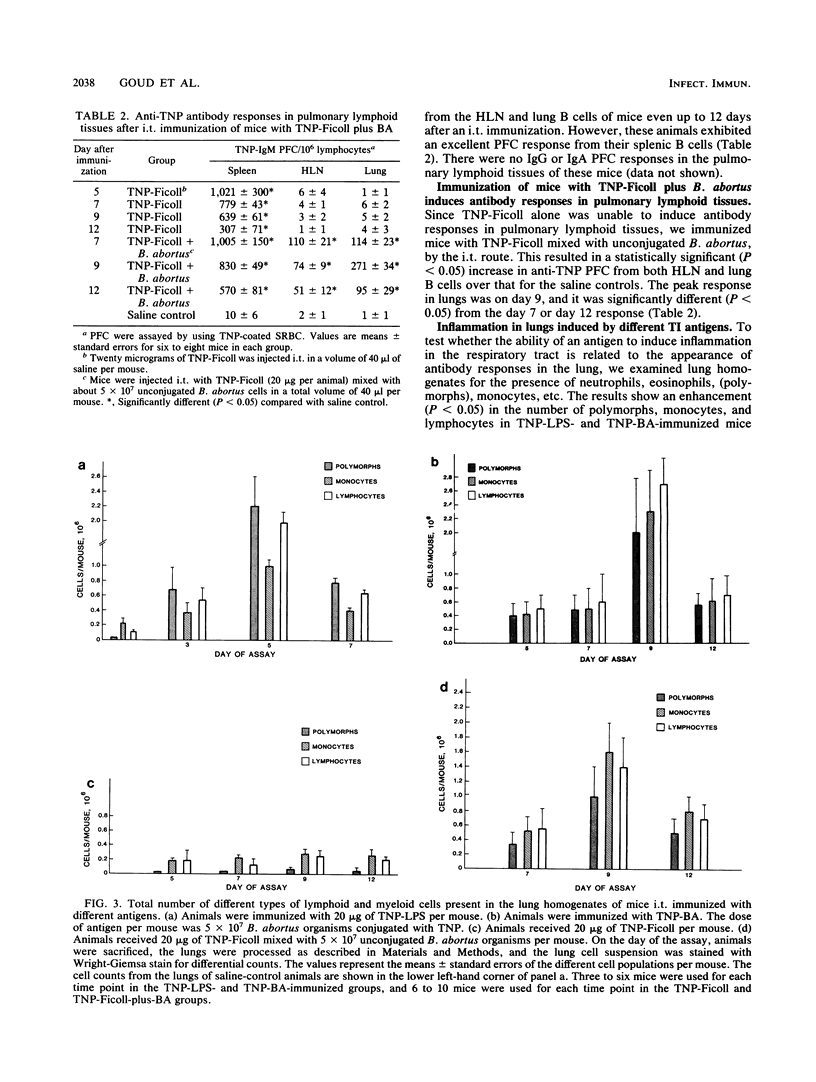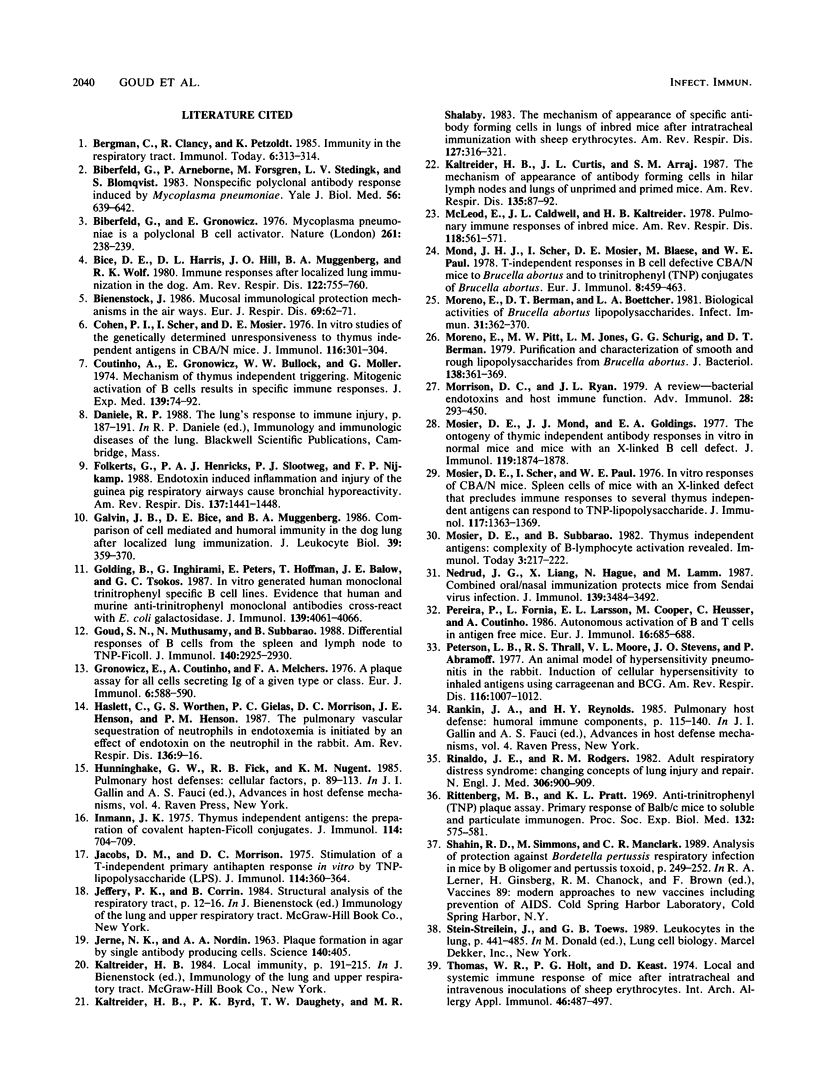Abstract
B lymphocytes from the pulmonary lymphoid tissues were stimulated with a variety of thymus-independent (TI) antigens by intratracheal (i.t.) immunization. Immune responses in the lungs and hilar lymph nodes (HLN), which are part of the localized lymphoid tissue, as well as in the spleen, the systemic lymphoid organ, were studied. Thus, primary i.t. immunization of mice with the TI-1 antigen trinitrophenyl-lipopolysaccharide (TNP-LPS) elicited both antigen-specific and polyclonal plaque-forming cell responses from HLN, lung, and splenic B lymphocytes. These responses appeared as early as 3 days after immunization and declined by day 7. Similar immunization with another TI-1 antigen, TNP-Brucella abortus, resulted in anti-TNP responses in both pulmonary and systemic lymphoid tissues, although the kinetics of the antibody response were different than those to TNP-LPS. Interestingly an i.t. immunization with a TI-2 antigen, TNP-Ficoll, failed to induce an anti-TNP PFC response from HLN and lung B cells, although there was good antibody formation from splenic B cells. Antibody response to TNP-Ficoll was restored in pulmonary tissues when mice were immunized with TNP-Ficoll mixed with unconjugated B. abortus. In conclusion, our results indicate that TI-1 and TI-2 antigens differ in their ability to induce antibody responses in the pulmonary lymphoid tissues. The inability of TNP-Ficoll to elicit an antibody response in pulmonary lymphoid tissues has significance in the development of vaccines containing bacterial polysaccharides.
Full text
PDF






Selected References
These references are in PubMed. This may not be the complete list of references from this article.
- Biberfeld G., Arneborn P., Forsgren M., von Stedingk L. V., Blomqvist S. Non-specific polyclonal antibody response induced by Mycoplasma pneumoniae. Yale J Biol Med. 1983 Sep-Dec;56(5-6):639–642. [PMC free article] [PubMed] [Google Scholar]
- Biberfeld G., Gronowicz E. Mycoplasma pneumoniae is a polyclonal B-cell activator. Nature. 1976 May 20;261(5557):238–239. doi: 10.1038/261238a0. [DOI] [PubMed] [Google Scholar]
- Bice D. E., Harris D. L., Hill J. O., Muggenburg B. A., Wolff R. K. Immune responses after localized lung immunization in the dog. Am Rev Respir Dis. 1980 Nov;122(5):755–760. doi: 10.1164/arrd.1980.122.5.755. [DOI] [PubMed] [Google Scholar]
- Bienenstock J. Mucosal immunological protection mechanisms in the airways. Eur J Respir Dis Suppl. 1986;147:62–71. [PubMed] [Google Scholar]
- Cohen P. L., Scher I., Mosier D. E. In vitro studies of the genetically determined unresponsiveness to thymus-independent antigens in CBA/N mice. J Immunol. 1976 Feb;116(2):301–304. [PubMed] [Google Scholar]
- Coutinho A., Gronowicz E., Bullock W. W., Möller G. Mechanism of thymus-independent immunocyte triggering. Mitogenic activation of B cells results in specific immune responses. J Exp Med. 1974 Jan 1;139(1):74–92. doi: 10.1084/jem.139.1.74. [DOI] [PMC free article] [PubMed] [Google Scholar]
- Folkerts G., Henricks P. A., Slootweg P. J., Nijkamp F. P. Endotoxin-induced inflammation and injury of the guinea pig respiratory airways cause bronchial hyporeactivity. Am Rev Respir Dis. 1988 Jun;137(6):1441–1448. doi: 10.1164/ajrccm/137.6.1441. [DOI] [PubMed] [Google Scholar]
- Galvin J. B., Bice D. E., Muggenburg B. A. Comparison of cell-mediated and humoral immunity in the dog lung after localized lung immunization. J Leukoc Biol. 1986 Apr;39(4):359–370. doi: 10.1002/jlb.39.4.359. [DOI] [PubMed] [Google Scholar]
- Golding B., Inghirami G., Peters E., Hoffman T., Balow J. E., Tsokos G. C. In vitro generated human monoclonal trinitrophenyl-specific B cell lines. Evidence that human and murine anti-trinitrophenyl monoclonal antibodies cross-react with Escherichia coli beta-galactosidase. J Immunol. 1987 Dec 15;139(12):4061–4066. [PubMed] [Google Scholar]
- Goud S. N., Muthusamy N., Subbarao B. Differential responses of B cells from the spleen and lymph node to TNP-Ficoll. J Immunol. 1988 May 1;140(9):2925–2930. [PubMed] [Google Scholar]
- Gronowicz E., Coutinho A., Melchers F. A plaque assay for all cells secreting Ig of a given type or class. Eur J Immunol. 1976 Aug;6(8):588–590. doi: 10.1002/eji.1830060812. [DOI] [PubMed] [Google Scholar]
- Haslett C., Worthen G. S., Giclas P. C., Morrison D. C., Henson J. E., Henson P. M. The pulmonary vascular sequestration of neutrophils in endotoxemia is initiated by an effect of endotoxin on the neutrophil in the rabbit. Am Rev Respir Dis. 1987 Jul;136(1):9–18. doi: 10.1164/ajrccm/136.1.9. [DOI] [PubMed] [Google Scholar]
- Inman J. K. Thymus-independent antigens: the preparation of covalent, hapten-ficoll conjugates. J Immunol. 1975 Feb;114(2 Pt 1):704–709. [PubMed] [Google Scholar]
- Jacobs D. M., Morrison D. C. Stimulation of a T-independent primary anti-hapten response in vitro by TNP-lipopolysaccharide (TNP-LPS). J Immunol. 1975 Jan;114(1 Pt 2):360–364. [PubMed] [Google Scholar]
- Kaltreider H. B., Byrd P. K., Daughety T. W., Shalaby M. R. The mechanism of appearance of specific antibody-forming cells in lungs of inbred mice after intratracheal immunization with sheep erythrocytes. Am Rev Respir Dis. 1983 Mar;127(3):316–321. doi: 10.1164/arrd.1983.127.3.316. [DOI] [PubMed] [Google Scholar]
- Kaltreider H. B., Curtis J. L., Arraj S. M. The mechanism of appearance of specific antibody-forming cells in lungs of inbred mice after immunization with sheep erythrocytes intratracheally. II. Dose-dependence and kinetics of appearance of antibody-forming cells in hilar lymph nodes and lungs of unprimed and primed mice. Am Rev Respir Dis. 1987 Jan;135(1):87–92. doi: 10.1164/arrd.1987.135.1.87. [DOI] [PubMed] [Google Scholar]
- McLeod E., Caldwell J. L., Kaltreider H. B. Pulmonary immune responses of inbred mice. Appearance of antibody-forming cells in C57BL/6 mice after intrapulmonary or systemic immunization with sheep erythrocytes. Am Rev Respir Dis. 1978 Sep;118(3):561–571. doi: 10.1164/arrd.1978.118.3.561. [DOI] [PubMed] [Google Scholar]
- Mond J. J., Scher I., Mosier D. E., Baese M., Paul W. E. T-independent responses in B cell-defective CBA/N mice to Brucella abortus and to trinitrophenyl (TNP) conjugates of Brucella abortus. Eur J Immunol. 1978 Jul;8(7):459–463. doi: 10.1002/eji.1830080703. [DOI] [PubMed] [Google Scholar]
- Moreno E., Berman D. T., Boettcher L. A. Biological activities of Brucella abortus lipopolysaccharides. Infect Immun. 1981 Jan;31(1):362–370. doi: 10.1128/iai.31.1.362-370.1981. [DOI] [PMC free article] [PubMed] [Google Scholar]
- Moreno E., Pitt M. W., Jones L. M., Schurig G. G., Berman D. T. Purification and characterization of smooth and rough lipopolysaccharides from Brucella abortus. J Bacteriol. 1979 May;138(2):361–369. doi: 10.1128/jb.138.2.361-369.1979. [DOI] [PMC free article] [PubMed] [Google Scholar]
- Morrison D. C., Ryan J. L. Bacterial endotoxins and host immune responses. Adv Immunol. 1979;28:293–450. doi: 10.1016/s0065-2776(08)60802-0. [DOI] [PubMed] [Google Scholar]
- Mosier D. E., Mond J. J., Goldings E. A. The ontogeny of thymic independent antibody responses in vitro in normal mice and mice with an X-linked B cell defect. J Immunol. 1977 Dec;119(6):1874–1878. [PubMed] [Google Scholar]
- Mosier D. E., Scher I., Paul W. E. In vitro responses of CBA/N mice: spleen cells of mice with an X-linked defect that precludes immune responses to several thymus-independent antigens can respond to TNP-lipopolysaccharide. J Immunol. 1976 Oct;117(4):1363–1369. [PubMed] [Google Scholar]
- Nedrud J. G., Liang X. P., Hague N., Lamm M. E. Combined oral/nasal immunization protects mice from Sendai virus infection. J Immunol. 1987 Nov 15;139(10):3484–3492. [PubMed] [Google Scholar]
- Pereira P., Forni L., Larsson E. L., Cooper M., Heusser C., Coutinho A. Autonomous activation of B and T cells in antigen-free mice. Eur J Immunol. 1986 Jun;16(6):685–688. doi: 10.1002/eji.1830160616. [DOI] [PubMed] [Google Scholar]
- Peterson L. B., Thrall R. S., Moore V. L., Stevens J. O., Abramoff P. An animal model of hypersensitivity pneumonitis in the rabbit. Induction of cellular hypersensitivy to inhaled antigens using carrageenan and BCG. Am Rev Respir Dis. 1977 Dec;116(6):1007–1012. doi: 10.1164/arrd.1977.116.6.1007. [DOI] [PubMed] [Google Scholar]
- Rinaldo J. E., Rogers R. M. Adult respiratory-distress syndrome: changing concepts of lung injury and repair. N Engl J Med. 1982 Apr 15;306(15):900–909. doi: 10.1056/NEJM198204153061504. [DOI] [PubMed] [Google Scholar]
- Rittenberg M. B., Pratt K. L. Antitrinitrophenyl (TNP) plaque assay. Primary response of Balb/c mice to soluble and particulate immunogen. Proc Soc Exp Biol Med. 1969 Nov;132(2):575–581. doi: 10.3181/00379727-132-34264. [DOI] [PubMed] [Google Scholar]
- Thomas W. R., Holt P. G., Keast D. Local and systemic immune response of mice after intratracheal and intravenous inoculations of sheep erythrocytes. Int Arch Allergy Appl Immunol. 1974;46(4):487–497. doi: 10.1159/000231152. [DOI] [PubMed] [Google Scholar]
- Weisz-Carrington P., Grimes S. R., Jr, Lamm M. E. Gut-associated lymphoid tissue as source of an IgA immune response in respiratory tissues after oral immunization and intrabronchial challenge. Cell Immunol. 1987 Apr 15;106(1):132–138. doi: 10.1016/0008-8749(87)90156-0. [DOI] [PubMed] [Google Scholar]
- Yoshizawa Y., Dawson C. A., Roberts R. C., Moore V. L. The distribution of soluble antigens instilled into the respiratory tract. Modulation by immunity and inflammation. Chest. 1982 Jul;82(1):93–97. doi: 10.1378/chest.82.1.93. [DOI] [PubMed] [Google Scholar]
- Young E. J. Human brucellosis. Rev Infect Dis. 1983 Sep-Oct;5(5):821–842. doi: 10.1093/clinids/5.5.821. [DOI] [PubMed] [Google Scholar]


